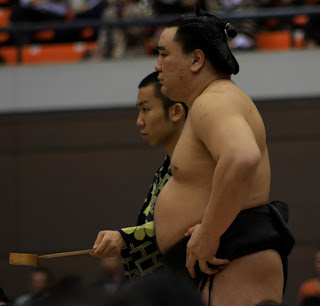The Hall of Awa Japanese Handmade Paper, as it is known in English, is an hour on a train from Tokushima station. It was our first train trip since arriving here, and we were pretty excited to be back on our preferred method of transport. Since it was an hour’s worth of travel to get there, and since the hands-on demonstration reportedly lasts an hour, and because the demonstrations close at 4:00, I was afraid of going too late in the day.
We managed to arrive around 1:30, so had plenty of time. We walked in, and there was no one at the desk. Either of the two desks. One labelled, “Information,” and the other clearly the cash register for the little shop (did I mention I like a little shop?)
We wandered the little shop (and I do mean little), which took all 90 seconds walking very slowly and picking up everything to examine more closely. But the tactic worked, and there was a woman at the information desk when we came out.
I walked up to her smiled and said hello.
Then we stared at each other for a bit.
Normally when I walk into a museum, they person behind the desk pulls out a brochure, tells me how much the admission fee is, and all is well and good. Protocol is key with my limited Japanese.
This woman did not follow protocol. She stared at me as if I were at a restaurant and had a choice. Did she expect me to say, “I’d rather not pay the the 300 yen entry fee, if that’s all right by you.”
After fumbling with Japanese inside my head, I managed to ask about the gallery I had seen on the internet. Actually, I asked about an “art museum,” which threw her off, but she corrected me that they have a gallery.
Whatever. I just wanted to look at paper. Of course, the gallery, once everything finally got sorted, turned out to be full of scarves and jackets, but no paper.
We paid our admission fee, also explaining that we wanted to make postcards. While she prepared the demonstration area, we wandered the small gallery full of fabric and looked down onto the open paper-making room, where the professionals create their handmade paper to sell all around the world.
I made paper once, when I was in high school at a summer camp. We used twigs and leaves and made very rustic, chunky paper. I remember thinking it was a great idea, but was not satisfied with the result.
Standing next to a television obviously meant for an explanatory video - for those who speak Japanese - I wondered if this was a mistake. Would today be a repeat of making paper in high school ... nice, but with something missing?
Near tears and frustrated, I wandered through the scarves, lamenting I couldn’t ask her - among all my other questions - what the connection is between these and paper-making. (The brochure claims the exhibits, no matter what they are, always have a connection).
Finally, the patient woman came upstairs to tell us the demonstration area was ready. We followed her through the open hall, past people stirring, sifting, flattening and ... pulling apart. Off in a room by themselves two women were preparing the plant fibre; this paper is made by hand from the earth up.
Okay, that’s pretty cool.
Luckily, a hands-on demonstration is, by its very nature, one in which language is secondary to the process. She walked us through it, and then left us alone to play.
Making the paper was easy enough. Decorating it not so much.
Laid out on a table were neon colours surely not found in the natural world. Pink and orange and blue straight out of the 1980s. We used cookie cutters to make shapes, squirt bottles and cups of coloured water, and a lot of prayers to keep the colours from running together.
Meanwhile, our caretaker flitted about us, like a helpful butterfly: taking our used tools and washing them, making approving noises when we finally got a design to look good, handing us the roller when we needed it. I wished I could ask her how long she has worked at the paper factory, how much paper they make in a day, and what her favourite part of the job is.
In the end, with my Japanese being spotty, I settled on one my most comfortable sentences, of which I know all the words: “What’s your name?”
Yoshida-San.
Thank you, Yoshida-San, for all you did for us. We did appreciate it, and I hope my very little Japanese could get that across in the end.


















































